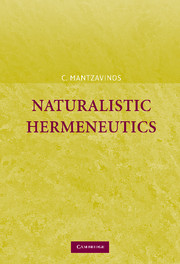Book contents
- Frontmatter
- Contents
- Preface
- Acknowledgments
- Naturalistic Hermeneutics
- PART I HERMENEUTIC DEAD ENDS
- PART II HERMENEUTIC WAYS OUT
- 4 The Problematic of Meaning: The Naturalistic Way Out
- 5 The Apprehension of the Meaning of Actions
- 6 The Apprehension of the Meaning of Texts
- Epilogue
- References
- Author Index
- Subject Index
4 - The Problematic of Meaning: The Naturalistic Way Out
Published online by Cambridge University Press: 13 August 2009
- Frontmatter
- Contents
- Preface
- Acknowledgments
- Naturalistic Hermeneutics
- PART I HERMENEUTIC DEAD ENDS
- PART II HERMENEUTIC WAYS OUT
- 4 The Problematic of Meaning: The Naturalistic Way Out
- 5 The Apprehension of the Meaning of Actions
- 6 The Apprehension of the Meaning of Texts
- Epilogue
- References
- Author Index
- Subject Index
Summary
WHAT TYPES OF NEXUSES ARE THERE?
Having presented and criticized three basic hermeneutic models in their systematic intention in the first part of the book, my goal of this second part is to highlight a naturalistic way of coping with the problematic of meaning. In this chapter, I will explain what types of nexuses there are before sketching out the naturalistic way of dealing with the problematic of meaning and plead for a unified approach to nexuses. In Chapters 5 and 6, I will then attempt to show that both human action in general and the results of such action, above all texts, can be easily grasped with a unified method.
Let's start with the plausible question concerning which types of nexuses can be apprehended. The answer to this question is simple: There are either nexuses of meaning or causal nexuses. A somewhat complex issue is which type of nexuses occur in which area of reality, or whether perhaps there are exclusively nexuses of meaning or exclusively causal nexuses.
Three positions are possible regarding this issue: One can argue that there are only causal nexuses or only nexuses of meaning in all areas of reality, or that there are certain areas of reality in which only nexuses of meaning arise and others in which only causal nexuses arise.
- Type
- Chapter
- Information
- Naturalistic Hermeneutics , pp. 73 - 86Publisher: Cambridge University PressPrint publication year: 2005

